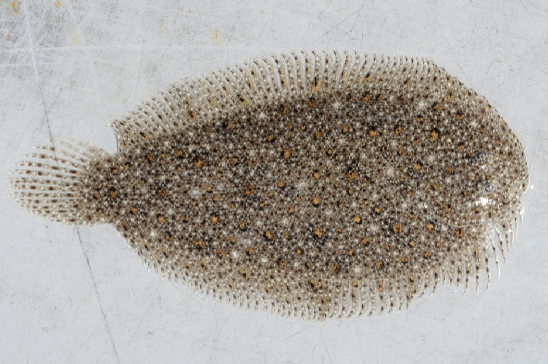Elongate Flounder, Ammotretis elongatus McCulloch 1914
Other Names: Elongated Flounder

An Elongate Flounder, Ammotretis elongatus, from Western Australia. Source: Chris Dowling / Fishbase . License: All rights reserved
Summary:
A sandy coloured flounder with small black spots covering the head, body and fins, and a whitish underside.
Cite this page as:
Bray, D.J. & Bradley, E. 2022, Ammotretis elongatus in Fishes of Australia, accessed 01 Jul 2025, https://fishesofaustralia.net.au/Home/species/983
Elongate Flounder, Ammotretis elongatus McCulloch 1914
More Info
|
Distribution |
South of Kangaroo Island, South Australia, to Geraldton, Western Australia. Inhabits sandy areas in shallow inshore waters including estuaries, at depths to 20 m. |
|
Features |
Dorsal fin 74-75; Anal fin 50-51; Pelvic fin right side 12-14, left side 3-4; Caudal fin 14. Body moderately deep (40-43% SL). Snout extended into a hook-like process projecting downwards in front of small, oblique mouth; teeth small, in narrow band in each jaw. Scales very small, rather firmly attached; ctenoid or cycloid on ocular side; scales mostly ctenoid on blind side, giving this side a rough texture; lateral line on both sides with very slight dorsal curve above pectoral fins. Dorsal, anal and caudal fins separate; dorsal fin arising on tip of snout, without elongate anterior rays; caudal fin rounded; both pectoral fins of similar form and size. |
|
Size |
Reaches a length of 22 cm TL. |
|
Colour |
The eyed side (right side) is sandy in colour, head, body and fins covered in tiny black spots; blind side (left side) whitish. |
|
Feeding |
Often lies buried in sand and feeds on benthic invertebrates - mostly small crustaceans such as cumaceans, tanaids, amphipods, and small polychaete worms. |
|
Biology |
In Western Australia, juveniles recruit to sandy beaches during or just before October-November. |
|
Fisheries |
The species is infrequently taken in trawl surveys off southwestern Australia. |
|
Remarks |
Individuals become increasingly elongate with growth. |
|
Etymology |
The specific name is from the Latin elongatus (= elongate) in reference to the 'comparatively narrow form' of this species compared with other species of Ammotretis known at the time. |
|
Species Citation |
Ammotretis elongatus McCulloch 1914, Biological Results of the Fishing Experiments carried on by the F.I.S. Endeavour 1909-1914 2(3): 123, pl. 27. Type locality: Investigator Strait, or the area south of Kangaroo Island, South Australia. |
|
Author |
Bray, D.J. & Bradley, E. 2022 |
|
Resources |
Elongate Flounder, Ammotretis elongatus McCulloch 1914
References
Gomon, M.F. 1994. Family Pleuronectidae. pp. 851-859, figs 753-760 in Gomon, M.F., Glover, C.J.M. & Kuiter, R.H. (eds). The Fishes of Australia's South Coast. Adelaide : State Printer 992 pp. 810 figs.
Gomon, M.F. 2008. Family Rhombosoleidae. pp. 810-816 in Gomon, M.F., Bray, D.J. & Kuiter, R.H. (eds). Fishes of Australia's Southern Coast. Sydney : Reed New Holland 928 pp.
Hourston, M., Platell, M.E., Valesini, E.J. & Potter, I.C. 2004. Factors influencing the diets of four mrophologically divergent fish species in nearshore marine waters. Journal of the Marine Biological Association of the United Kingdom 84(4): 805-817 http://dx.doi.org/10.1017/S0025315404009981h
Hyndes, G.A., Platell, M.E., Potter, I.C. & Lenanton, R.C.J. 1999. Does the composition of the demersal fish assemblages in temperate coastal waters change with depth and undergo consistent seasonal changes? Marine Biology 134: 335-352.
Kuiter, R.H. 1993. Coastal Fishes of South-eastern Australia. Bathurst : Crawford House Press 437 pp.
May, J.L. & Maxwell, J.G.H. 1986. Field Guide to Trawl Fish from Temperate Waters of Australia. Hobart : CSIRO Division of Marine Research 492 pp.
McCulloch, A.R. 1914. Report on some fishes obtained by the F.I.S. Endeavour on the coasts of Queensland, New South Wales, Victoria, Tasmania, South and South-Western Australia. Part 2. Biological Results of the Fishing Experiments carried on by the F.I.S. Endeavour 1909-1914 2(3): 77-165 figs 1-15 pls 13-34 See ref at BHL
Munroe, T.A. 2021. Ammotretis elongatus. The IUCN Red List of Threatened Species 2021: e.T158640029A158673982. https://dx.doi.org/10.2305/IUCN.UK.2021-2.RLTS.T158640029A158673982.en. Accessed on 13 January 2022.
Norman, J.R. 1926. A report on the flatfishes (Heterosomata) collected by the F.I.S. Endeavour, with a synopsis of the flatfishes of Australia and a revision of the subfamily Rhombosoleinae. Biological Results of the Fishing Experiments carried on by the F.I.S. Endeavour 1909-1914 5(5): 219-308 figs 1-15 See ref at BHL
Norman, J.R. 1934. A Systematic Monograph of the Flatfishes (Heterosomata) Psettodidae, Bothidae, Pleuronectidae. London : British Museum Vol. 1 459 pp. 317 figs. See ref at BHL
Sakamoto, K. 1984. Interrelationships of the Family Pleuronectidae (Pisces: Pleuronectiformes). Memoirs of the Faculty of Fisheries, Hokkaido University 31(1,2): 95-215 figs 1-51
Vanderklift, M.A. 1996. Influence of adjacent seagrass on the fish assemblages off sandy beaches. MSc. Thesis, Edith Cowan University, Perth https://ro.ecu.edu.au/theses/946







